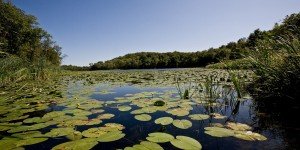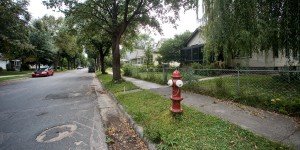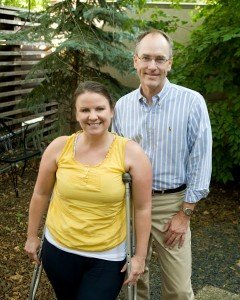Article and photos by MARGIE O’LOUGHLIN
Minnesota may be known as the land of 10,000 lakes, but the state actually has 11,842 lakes that measure 10 acres or larger. All but four Minnesota counties contain at least one lake, and we have more shoreline than the golden state of California.
The Freshwater Society (FWS) educates and inspires citizens to value, conserve and protect our water resources. In July, the venerable non-profit moved from Excelsior to the Midway neighborhood because, as executive director Steve Woods said, “We go where the work is.” Their new address is 2424 Territorial Rd.
 Photo right: Want to learn more about lakes? Check out honorary FWS board member Darby Nelson’s book “For Love of Lakes” at the St. Paul Public Library. The book weaves a tapestry of history, science and poetry for those who value lakes and waterways.
Photo right: Want to learn more about lakes? Check out honorary FWS board member Darby Nelson’s book “For Love of Lakes” at the St. Paul Public Library. The book weaves a tapestry of history, science and poetry for those who value lakes and waterways.
Woods and his team of 12 employees are happy to be here. Following what he called, “a shift in board strategy,” they’re at the Capitol more often these days, and it just made sense to be closer. The organization frequently partners with foundations, watershed districts, Minnesota Public Radio and the College of Biological Sciences at the U of M—most of which are now only minutes away on the Green Line.
While Minnesota doesn’t have a problem with water quantity, we do have a problem with water quality. According to the FWS, an estimated 40% of our lakes and rivers suffer some pollution and are considered “impaired.” A significant contributor to water pollution is agriculture, which covers about half of the state. Woods pointed out, “Everything that happens on the land affects the water around us.”
 Photo left: Because of impervious surfaces like pavement and rooftops, a typical city block creates more than five times the runoff of a woodland area measuring the same size.
Photo left: Because of impervious surfaces like pavement and rooftops, a typical city block creates more than five times the runoff of a woodland area measuring the same size.
The FWS has two main areas of concentration: groundwater sustainability and stormwater runoff. Woods said, “We don’t want to be an inch deep and a mile wide. We focus on drafting policies that improve water quality, and then get neighbors involved through our citizen engagement programs.”
To understand groundwater sustainability, you have to understand aquifers. Aquifers, which are not visible, are slowly being drained down across the state. Private wells are filled from aquifers and supply three out of every four Minnesota households. People often think of aquifers as underground lakes. They’re actually sand and gravel deposits, in which water saturates the empty spaces. Groundwater flows out of aquifers and sustains many of our lakes and rivers. When the aquifers get low enough, the lakes and rivers lose volume too.
There are plenty of things that citizens can do to protect groundwater quality and supply. For starters, dispose of hazardous waste properly. Hazardous waste includes things like paint, garden chemicals, nail polish remover and oven cleaner. Ramsey County’s year-round collection and product re-use center is located at 5 Empire Dr. (just north of University Ave. between Rice and Jackson streets).
Reduce the size of your lawn by planting native plants and grasses. Reduce the amount of fertilizer and lawn chemicals that you use. Reduce the amount of salt on driveways and sidewalks this winter (it doesn’t work below 15 degrees Fahrenheit anyhow). All of these chemicals can become part of storm water runoff, ending up in lakes, rivers and, in some cases, groundwater.
One of the FWS’s major community engagement programs is called Master Water Stewards. The goal of that program is to train citizens to combat storm water runoff in their own neighborhood. Program participants attend lectures and hands-on classes over the course of eight months and become well-versed in water science, pollution causes, and solutions.
 “Our Master Water Steward graduates are bi-lingual,” said Deirdre Coleman, FWS’s program coordinator. “They speak both science and English.” She was quick to point out that anyone can apply, and that a background in science is not required to be accepted.
“Our Master Water Steward graduates are bi-lingual,” said Deirdre Coleman, FWS’s program coordinator. “They speak both science and English.” She was quick to point out that anyone can apply, and that a background in science is not required to be accepted.
Photo left: Deirdre Coleman (L), project coordinator, said she’s been paddling a canoe on Minnesota rivers and lakes ever since she was old enough to sit up. Steve Woods (R), executive director, described himself as “nearly amphibious.” He canoes, swims and, in general, is happiest when he’s on or near the water.
“What we’re really interested in is people who are connected to their communities,” Coleman said. Contact dcoleman@freshwater.org to learn more.
It’s not too late to register for the 2016 Master Water Steward program, which will begin in January. Modeled after the successful Master Gardener and Master Naturalist programs, the class of 2016 hopes to graduate 75 passionate water stewards--who will then be able to help neighbors manage their own storm water better.
The FWS provides other opportunities for education in the community. Their now famous Weather Guide Calendar is full of valuable information for citizen scientists of all ages. It’s available through local independent bookstores. For bulk purchases, contact the FWS directly. The Weather Guide Calendar is also available for schools to buy, along with an accompanying curriculum guide. It’s an excellent tool for teaching about the weather, earth science, meteorology and phenology, and provides a dependable source of operating revenue for the FWS. It’s a big seller!
On Tue., Nov. 3, the FWS will be sponsoring their annual Moos Family Speaker Series on Water Resources. The event is free and open to the public. Join William Stowe, CEO and general manager of the Des Moines, Iowa, Water Utility. Stowe, who is part-engineer, part-attorney, and part-philosopher, will speak on the challenges of providing safe drinking water to half a million customers in a heavily agricultural area. The presentation begins in the St. Paul Student Center Auditorium (2017 Buford Ave.) at 7pm and all are welcome.
Comments
No comments on this item Please log in to comment by clicking here